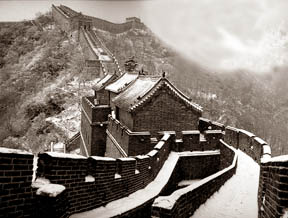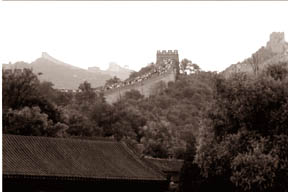|
observer |
|
|
|
|
|
OTHER LINKS |

|

|

|
Highway to heaven?
It embodies the unfailing effort of Chinese monarchs who drove their people, even to death, towards completion of this gigantic edifice. The Great Wall provided protection for the Chinese kingdoms, was a means of movement of the troops, and was also a highway for the connection of watch towers, through terrain which could otherwise, even today, be reached only by professional mountaineers. "Amazing"The Chinese here, say that their awesome piece of security construction was completed around 2,200 years ago. In 1991, the aspiring president of the US, Bill Clinton and Lady Hilary, climbed the Mutiany section of the Great Wall. Here, the Great Wall descends in a series of escarpments, snaking its way across the mountains like a titanic dragon. A comfortable and safe cableway whisks tourists up and down the Great Wall. "Amazing, amazing," was all that Clinton could say. The Great Wall is not the boundary of China, our young guide, Wen Tong, or Wendy to foreigners said. The Great Wall was built from the north, to protect the monarchs and the capital city, Beijing, from invaders. Spanning a total of 5,660 kilometres, the wall starts from the banks of the Yalu River in the east and meanders towards the Qilian and Tianshan mountains to the west. Much of where the Great Wall lies, is hilly, and uninhabitable terrain. Climbing some parts, needs sheer muscle power, for the steps, are so high, one above the other, one slip, and you see a smiling Peter. The thought of Genghis Khan, is spine chilling. History says that he had broken through the Great Wall. History records Genghis Khan: `There is no greater happiness than to conquer a people, and rape his wives and daughters.' The gully in which the pass stands stretches 20 more kilometres.
It is heavily wooded and the scenery is captivating. A famed scenic spot, known as Juyong Verdure is situated, here. The Great Wall at Jinshanling runs through mountain peaks for 7.5 kilometres from Gubeikou Pass. Then, a section of the Great Wall stands on the ridge of an awesome mountain. On Mount Simatai, the ridges are very narrow, sometimes 40 centimetres, below, dangerous precipices. To strengthen defence capabilities two-brick walls were built to connect the watch towers. So, it is called the One Side Wall. Ocean of cloudsThe Huangya Pass of the Great Wall stands 30 kilometres north of Jixiana at Watch Bay. Here, the defence works on the Great Wall were built on sheer and irregular mountain projections of strategic importance. But, how man ever scaled those heights, let alone build, it, is far more than, "Amazing. Amazing." There is a section of the Great Wall which resembles a bow. The scene changes, again, continuing southwards, the Great Wall looks as if it is soaring into an ocean of clouds as it runs across the former territories of the ancient states of Yan and Zhaol. Now, the Great Wall at night, at Baldaling, is painted in yellow and white light, and green on its pathways. "Amazing. Amazing." Arrow Nock, as the name suggests, this part of the Great Wall looks like hanging precariously at the edge of a sheer cliff. The Huangya pass of the Great Wall stands 30 kilometres north of Jixian Country and 100 kilometres from Tianjin. A round watchtower named Phoenix Tower is 23 metres in height and 16 metres in diameter. It stands several thousand metres outside the pass as a menacing sight to invaders. South of the pass is China's first Great Wall museum. The Shanghai Pass is situated at the foot of a mountain and in the vicinity of the sea in the northeast corner of the city of Qinhangdao, Herbie Province. Built by Xu Da, the famous Ming dynasty general in 1381 or the 14th year of the Hongwa reign, the pass is the most important one in the eastern part of the entire Great Wall. This pass features four gates, Zhendong, Ying'en, Wa Ngyang and Weiyuanr. The wall stands 14 metres high, lined with brick and stone. Five Chinese Characters, each 1.6 metres in height means "First Pass Under Heaven." Beyond Shanghai Pass the Great Wall stretches eastward until it dips in the sea at a place called Laolongtou (Old Dragon's Head). Tourist attractions in the vicinity include the Jiaoshan Scenic Zone and a temple dedicated to Meng Jiangnu, a woman who died of sorrow when her husband was conscripted by Qinshihuang to build the Great Wall. Finally, the Great Wall enters the sea, four kilometres south of Shanhaiguan Pass. |
 The Great Wall of China is the only man-made structure which can be
seen with the naked eye from the moon, in testimony of its enormity. The
Great Wall which took hundreds of years to build is today a living
fossil of China's past.
The Great Wall of China is the only man-made structure which can be
seen with the naked eye from the moon, in testimony of its enormity. The
Great Wall which took hundreds of years to build is today a living
fossil of China's past. 








